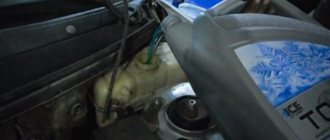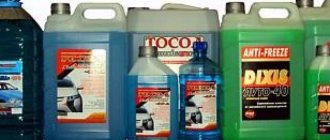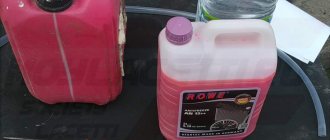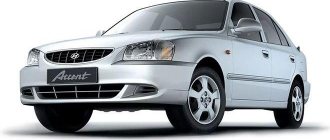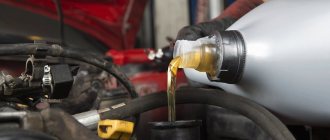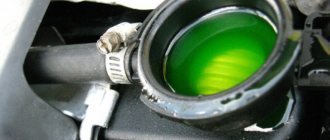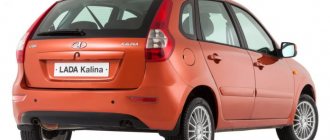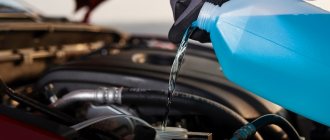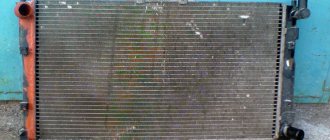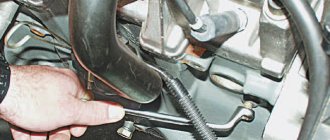Choosing what coolant to fill in the VAZ-2114?
Car : VAZ-2114. Asks : Syutkin Alexander. The essence of the question : what is better to fill in the cooling system of the VAZ-2114?
On my hatchback 2114, the antifreeze has not been changed since the factory. It was just topped up, but I don’t know the brand of liquid. I myself added distilled water to the tank, bringing the level to the MAX mark. But I know that you can’t do this - the freezing temperature rises. I would like to know what brand of antifreeze was filled in at the factory to completely replace it. Surely, only one coolant was poured into VAZ-2114 cars. Which one exactly?
COOLING SYSTEM VAZ 2114
Once upon a time, back in Soviet times, water was poured into a car radiator as coolant. But it was very inconvenient - in cold weather it had to be drained regularly so as not to defrost the system, and in the morning before the trip I had to run around with buckets of hot water. In addition, the cooling jacket in the cylinder block and in the cylinder head suffered from corrosion. Nowadays, water is practically no longer used; antifreeze or antifreeze is poured into the cooling system (CO).
The volume of VAZ 2114 coolant in CO is about 8 liters (7.8 liters according to factory conditions). A car that has rolled off the assembly line can be filled with any coolant; the manufacturer does not adhere to any specific rules in this matter.
But if the fluid runs out or the time has come to replace it, then topping up or replacing is necessary. And here you need to know what is poured into the system, and whether it is possible to mix antifreeze with antifreeze.
ANTIFREEZE
The name "antifreeze" contains Greek and English roots. The Greek “anti” means “against”, the English “freeze” translates to “freeze”. Therefore, the coolant located in the cooling system must not only prevent overheating of the internal combustion engine, but also not freeze in frosty weather. The basis of antifreeze is ethylene glycol, and the freezing point of the coolant depends on how much water is added to the chemical composition. The fluid components do not cause corrosion of engine parts.
The composition can be of almost any color; ethylene glycol itself is colorless. The composition is painted so that it can be seen in case of leakage, and so that it is not drunk by mistake; the antifreeze itself is poisonous. In addition, the old coolant changes color, which means it is time to replace it.
Antifreeze
Antifreeze is a type of antifreeze, only at one time it was specially developed for VAZ cars. It is blue in color and can be concentrated, diluted 60% with water (grade A-40M), diluted 35% (A-65M). The concentrate is not used in its pure form; it is diluted at your discretion, depending on the freezing temperature that is oriented towards in the region where the car is located. Antifreeze has a more aggressive environment, but this does not mean that it is of low quality.
What kind of liquid should be poured into the cooling system according to the passport?
Open the hood and look at the expansion tank. We see a sticker on top: it says “ TC Felix-40”. This means that Felix TC-40 antifreeze, produced in the city of Dzerzhinsk (Tosol-Sintez LLC), was filled with antifreeze.
The sticker on the tank must be present
If there is no sticker, we identify the liquid by color:
- Green – as indicated above;
- Yellow -green (light green ), there is a fluorescent effect - CoolStream Standart 40 (Tehnoform, Klimovsk).
There may be a blue coolant, but like the previous two, it is a G11 class antifreeze. The red liquid belongs to class G12 - further on it says how to dilute it.
Antifreeze can be sold in the form of a concentrate. Usually you need to add water (distillate) in a 1 to 1 ratio. Be careful!
G11 and G12 (antifreeze or antifreeze)
Compatibility table for antifreeze:
- Antifreeze class G11 – color blue, green or yellow-green. Can be diluted with antifreeze or G11 class antifreeze.
- Class G12 – red color. In principle, it is impossible to add coolant of another class (not G12).
When buying, you need to look not at the color, but only at the designations.
Antifreezes of two different classes
In the VAZ-2114 tank, the coolant can be colored red. If it was refilled upon release, then we are talking about Felix Carbox TC-40 (G12) antifreeze. When inspecting the tank, pay attention to the presence of smudges. If there are any, then the antifreeze is knocked out of the tank and the coolant boils.
Educational program by name: “antifreeze” is one of the types of antifreeze classified as class G11.
Concentration and proportions
Standard concentrates contain 3% water and freeze at low temperatures. To increase it to “-40”, the water content is adjusted to 50% (proportion “1 to 1”). According to VAZ requirements, the freezing temperature should be “-40” or lower. Draw conclusions.
If antifreeze freezes at “-50”, adding 1/10 of water raises the temperature to “-40”, and 1/5 to “-34”.
About the cooling system in general
The volume of the cooling system of engines 2111, 11183 and 21124 is the same. It is equal to 7.8 l. Part of the “old” fluid (1-2 l) remains in the system when replaced. Therefore, they do this: they fill the system with water (distillate), drive 10-20 km, and carry out the final replacement. All actions, of course, are performed in the warm season.
Ignition module - how to remove it
To get to the drain plug, you need to remove the ignition module from the 11183 engine. What needs to be done: disconnect the low-voltage connector, unscrew the three screws (see photo). You can then remove the module along with the bracket.
It is better not to apply all the “folk advice” about adding various acids to the wash water. It is unknown how a liter of antifreeze will react with vinegar or citric acid. But the stove tap must be opened when flushing.
For replacement (factory recommendations for choosing coolant)
For a complete replacement, it is recommended to choose any material from the list:
- CoolStream Standard – green, G11;
- CoolStream Premium – orange, meets the requirements of class G12+, but belongs to class G12 or G11 (the manufacturer does not specify);
- “Lada Concentrate” - G11, manufactured by “Bulgar Lada Plus” (Kazan) or “Oil Center” (Tolyatti);
- "Lada A-40" - the same as "Lada Concentrate", but in a ready-to-use form;
- OZhK, also OZh-40 or OZh-65 “TOSOL-TS” - different names and concentrations of antifreeze from the city of Dzerzhinsk (see above);
- OZhK, OZh-40 or OZh-65 “TOSOL-TORSA” – blue-green, G11;
- "Antifreeze G-48" - G11. The material has been discontinued and was produced in the city of Perm.
The photo below shows an example of a fake.
The name contains everything – Dzerzhinsk and A-40. Be careful.
Source
FILLING LIQUID INTO THE SYSTEM
What kind of coolant to pour into a VAZ 2114 is always a concern for car owners of these cars. There is no big difference, you can pour antifreeze into the cooling system, you can also add antifreeze, but mixing the compounds is still very undesirable. Antifreeze has a more aggressive environment due to other additives, and its too concentrated composition can even “corrode” the radiator over time. It is better to add to the radiator the brand of coolant that was previously filled in the system. If the brand is not known, then it is better to completely replace the fluid.
REPLACEMENT WITH WASHING
Is it possible to replace antifreeze with antifreeze? Why not. It is only necessary to flush the cooling system when replacing antifreeze with antifreeze. Conversely, you need to flush the cooling system when replacing antifreeze with antifreeze. We have already indicated the reason for flushing - the compositions are different and mixing can lead to foaming of the coolant. Of course, an explosion will not occur, but long-term use of the mixed composition is not recommended. The system should be flushed with clean water, and the water should be changed several times. Rinse until clear liquid, free of dirty impurities, drains from the radiator.
Replacing the coolant on a VAZ is done with your own hands in stages:
- We park the car level; at an angle, all the coolant may not drain out;
- Remove the expansion tank plug;
- Unscrew the drain plug at the bottom of the radiator. We prepare the container into which the contents from the radiator are drained in advance;
- We twist the plug on the cylinder block and drain the coolant from the block. To get to the plug, you need to remove the ignition module. The module is secured with three bolts;
- We tighten the plugs, fill in water and start the engine. Let the engine run for fifteen minutes;
- As already written above, we flush the system several times;
- Then fill in new fluid and remove the airlock. How many liters of antifreeze are provided in the VAZ 2114, so many should enter the system.
REMOVAL OF AIR CLOCK
How to add antifreeze if there is an air lock? There are different ways to fill liquid (discussed below).
Removing air through the throttle assembly:
- Remove one of the coolant supply hoses to the throttle valve.
- Remove the expansion tank cap and cover the tank with a clean rag.
- Blow through a rag into the reservoir until coolant flows from the removed hose.
- Quickly put the hose in place, tighten it with a clamp, and add fluid to the level. How much antifreeze will still fit into the VAZ 2114 depends on how “airy” the system is.
Removing air through the throttle without removing the expansion tank plug:
- We heat up the engine and turn it off.
- Remove one of the throttle hoses.
- After a short time, the air should come out and antifreeze should flow.
- We also quickly put on the hose.
- Check the coolant level and add it as necessary.
Bleeding air by placing the vehicle at an angle:
- We're heading uphill.
- Remove the tank cap.
- Warm up the engine to operating temperature.
- We accelerate sharply. If liquid falls into the system, add it.
You can change the cooling radiator on a VAZ yourself. In this case, an air lock may also form. You need to control how many liters of antifreeze will fit into the VAZ 2114. If there is a lot of new coolant left in the canister, it is necessary to remove the plug, otherwise the engine may overheat.
It should be remembered that the volume of the cooling system in the VAZ 2114 is approximately 7.5-8 liters.
If you don’t want to bother with replacing the coolant, you can take the car to a car service center. The cost of such work depends on the region and the level of equipment of the car workshop or center. On average, the price ranges from 300 to 600 rubles.
TIPS FOR REPLACING COOLANT
- Hot liquid must be drained carefully, using gloves and thick, waterproof clothing.
- After replacement, you need to check if there is an air lock in the system. The air must be expelled, otherwise the engine may overheat .
- When draining the liquid, cover the generator with a thick plastic bag or rag to prevent coolant from getting into it.
- When mixing antifreeze with antifreeze, nothing particularly bad will happen, but it is still advisable to avoid mixing.
Take into account all the nuances when replacing the coolant. Take care of your car!
What antifreeze does AvtoVAZ recommend?
For all VAZ engines (Lada Granta, Kalina, Priora, Niva 4x4), the manufacturer’s recommendations are the same (data from books on the operation, maintenance and repair of Lada cars):
- Antifreeze G-48;
- Cool Steam Standard;
- Cool Steam Premium;
- TS-Felix;
- Felix Carbox;
- SINTEC (for example, “Antifreeze SINTEC” TU 2422-047-51140047-2007);
- Long Life;
- G-Energy Antefreexe.
For K4M and K7M power units that are installed on Lada Largus, the manufacturer recommends GLACOEL RX antifreeze (type D). For Lada Vesta and XRAY, it is recommended to use Type D antifreeze based on a mixture of water and ethylene glycol. AvtoVAZ answer: the coolant in the VAZ 21179 engine cooling system is Sintec LUX G12 antifreeze (Sintec ANTIFREEZLUX G12).
Coolstream NRC in yellow is also used.
Is it possible to mix antifreeze?
Is it possible to mix antifreeze from different manufacturers? The operating manual for the Lada car states: “The use of mixtures of coolants of different brands is not allowed.”
Is it possible to mix antifreeze of different colors, but from the same manufacturer? There is no definite answer, because... Some manufacturers color the coolant “to taste,” while others add color based on the chemical composition or additives. According to statistics, about 85% of motorists do not mix antifreeze of different colors. At the same time, 64% believe that if you mix antifreeze of different colors, nothing bad will happen. You can view the survey and take part in it here.
The book on operation, maintenance and repair of the Lada Vesta car states:
Various dyes are added to antifreeze, giving the antifreeze a particular color that does not affect its operational and chemical properties. Therefore, when choosing antifreeze, you should pay attention not to its color, but to its chemical composition (type), recommended by the car manufacturer. If the antifreeze is concentrated, then it should be diluted with distilled water in a certain proportion. They are usually indicated on the label attached to the container.
What kind of liquid should be poured into the cooling system according to the passport?
Open the hood and look at the expansion tank. We see a sticker on top: it says “ TC Felix-40”. This means that Felix TC-40 antifreeze, produced in the city of Dzerzhinsk (Tosol-Sintez LLC), was filled with antifreeze.
There must be a sticker on the tank. If there is no sticker, we determine the liquid by color:
- Green – as indicated above;
- Yellow -green (light green ), there is a fluorescent effect - CoolStream Standart 40 (Tehnoform, Klimovsk).
There may be a blue coolant, but like the previous two, it is a G11 class antifreeze. The red liquid belongs to class G12 - further on it says how to dilute it.
Antifreeze can be sold in the form of a concentrate. Usually you need to add water (distillate) in a 1 to 1 ratio. Be careful!
How can I find out what kind of coolant was filled in at the factory?
In the vast majority of cases, it is very easy to find out the brand of antifreeze that was initially poured - just look at the sticker placed on the tank. This sticker always indicates in large letters the liquid with which the system was filled (and which it is recommended to add as needed).
In the vast majority of VAZ 2114 cars, the liquid filled at the factory is either Felix TC-40, produced in Dzerzhinsk, or CoolStream Standart 40, produced in Klimovsk. They can also be distinguished by color.
The first is bright green, the second is either green-yellow or faint green, in both cases there is slight fluorescence. Both of these liquids are antifreeze (belonging to class G11), and they can only be mixed with other liquids from this class.
Many people believe that Antifreeze is much worse in quality than antifreeze, so they cannot be mixed. This is incorrect - the reason lies not in the quality or acidity of the medium, but in the very different densities of these two liquids.
If it is not intended to replace the coolant with a liquid of a different category (for example, antifreeze for antifreeze), then you can add it without draining the entire cooling system. Otherwise, this operation will be strictly necessary.
G11 and G12 (antifreeze or antifreeze)
None Compatibility table for antifreeze:
- Antifreeze class G11 – color blue, green or yellow-green. Can be diluted with antifreeze or G11 class antifreeze.
- Class G12 – red color. In principle, it is impossible to add coolant of another class (not G12).
When buying, you need to look not at the color, but only at the designations.
Antifreeze of two different classes In the VAZ-2114 tank, the coolant can be colored red. If it was refilled upon release, then we are talking about Felix Carbox TC-40 (G12) antifreeze. When inspecting the tank, pay attention to the presence of smudges. If there are any, then the antifreeze is knocked out of the tank and the coolant boils.
About the cooling system in general
The volume of the cooling system of engines 2111, 11183 and 21124 is the same. It is equal to 7.8 liters. Part of the “old” fluid (1-2 l) remains in the system when replaced. Therefore, they do this: they fill the system with water (distillate), drive 10-20 km, and carry out the final replacement. All actions, of course, are performed in the warm season.
Ignition module - how to remove it To get to the drain plug, you need to remove the ignition module from the 11183 engine. What needs to be done: disconnect the low-voltage connector, unscrew the three screws (see photo). You can then remove the module along with the bracket.
Fluid replacement
If you plan to switch the car from antifreeze to antifreeze for any reason, then the old coolant should be drained by unscrewing the plugs in the block and in the radiator. It is worth remembering that this will not help remove the entire volume of coolant (and it is consistently equal to 7.8 liters).
In order to completely clean the entire system, you should fill it with ordinary water and drive the car for about 30 kilometers, after which you should drain everything again and add antifreeze. It goes without saying that this procedure can only be carried out in the warm season, but not in the cold.
Filling with antifreeze
It should be said right away that some motorists perform themselves and advise others to carry out additional procedures for cleaning the system of old coolant - adding vinegar, acetone and other additives to distilled water. It is strictly not recommended to carry out such operations. At best, they will be of no use; at worst, they can cause damage to the cooling system.
For replacement (factory recommendations for choosing coolant)
For a complete replacement, it is recommended to choose any material from the list:
- CoolStream Standard – green, G11;
- CoolStream Premium – orange, meets the requirements of class G12+, but belongs to class G12 or G11 (the manufacturer does not specify);
- “Lada Concentrate” - G11, manufactured by “Bulgar Lada Plus” (Kazan) or “Oil Center” (Tolyatti);
- "Lada A-40" - the same as "Lada Concentrate", but in a ready-to-use form;
- OZhK, also OZh-40 or OZh-65 “TOSOL-TS” - different names and concentrations of antifreeze from the city of Dzerzhinsk (see above);
- OZhK, OZh-40 or OZh-65 “TOSOL-TORSA” – blue-green, G11;
- "Antifreeze G-48" - G11. The material has been discontinued and was produced in the city of Perm.
Source
Choosing a coolant for the VAZ-2114: antifreeze or antifreeze, which is better?
It happens that car owners pay insufficient or no attention to the condition of the coolant in the cooling system. Moreover, there are cases when car enthusiasts don’t even know what’s in it. This behavior is extremely undesirable, because the stable operation of the engine as a whole depends on the condition of the cooling system.
The video below provides an overview and comparison of the general properties of antifreeze and antifreeze:
What categories of coolant can be mixed
Of course, the best option would be to fill the system only with liquids from one category, but if for some reason this is not possible, then you should use the following compatibility table:
- Antifreeze Tl - only with antifreeze Tl.
- G11 can be mixed with G13, G12+ and G12++.
- G11 must not be added to G12.
- G12 can be mixed with G12+, G++, G13.
- G13 cannot be mixed with G12, but with other types it can.
Being guided solely by the color of the coolant when purchasing/refilling/replacing it is fundamentally wrong. Some manufacturers paint antifreeze and antifreeze in colors different from the generally accepted ones. The color has no effect on the chemical composition and density of the liquid.
Properties of coolants
However, car owners are often faced with the question of what to fill, antifreeze or antifreeze! Below, we will talk about this in detail and figure out which is better. Such competition and the conditional division of coolant into antifreeze and antifreeze exist only in Russia.
After all, “TOSOL” is a non-freezing liquid created on the territory of the Soviet Union, and now this word is a common noun.
The main component of any modern “TOSOL” is ethylene glycol, and as a rule it is painted in two colors: blue - with a freezing point of -40C , and red - capable of withstanding frost down to -65 degrees Celsius .
And the concept, antifreeze is the generally accepted name for liquids capable of operating at subzero temperatures in internal combustion engines , and also as anti-icing liquids in aviation. The composition of antifreeze, as a rule, includes: propylene glycol (non-toxic substance - approx.), ethylene glycol, glycerin, as well as various additives that protect against corrosion.
The right choice means a lot
Judging by various experiments carried out by the most advanced and well-known automotive publications, we can say with confidence that more than 20% of all car breakdowns directly depend on the quality of the coolant filled in, and about 40% of breakdowns indirectly affect this. Therefore, the choice of such liquids is a responsible and important process, because the correct choice of coolant can save both money and time in the future.
Changing the coolant on the VAZ 2114 model
It is not so rare that cases occur when the happy owner of a passenger car drives his vehicle without even looking under the hood. Such exploitation is not permitted. For example, all the antifreeze may leak from the cooling system of an internal combustion engine, and then it will definitely be necessary to carry out a major overhaul of the engine. Therefore, it is necessary to monitor the presence of coolant (coolant) and know which one is poured into the system.
Monitor the presence of coolant
Difficult choice between antifreeze and antifreeze
In order to choose the right coolant, it is recommended to study in detail the manufacturer’s manual, which most often states what type of coolant is intended for the car. Such instructions are always supported by successful tests of these compounds, specifically for each type of car engine. In addition, the recommendations may include a class of liquids that are produced using the following technologies:
- Traditional - coolant created using this technology contains additives from inorganic salts, such as nitrites, nitrates, phosphates, etc.
- Carboxylate - a coolant created using this technology already has additives from organic salts and carbonates, which interact much better with the internal parts of the engine.
- Hybrid - this technology was created to create a type of carboxylate technology with the addition of inorganic acids. This is done to reduce the cost of the final product.
As you can understand, antifreeze is a liquid created using traditional technology, and antifreeze is created using carboxylate technology, which has clear advantages over the former.
Pros and cons of antifreeze
As it became clear, antifreeze has a number of advantages; below we will describe each of them in more detail. Antifreeze has many advantages over antifreeze, which you should definitely familiarize yourself with:
Heat dissipation
Coolants that are created using traditional technology (TOSOL - approx.) are capable of creating a protective film on the surface of the metal in the engine, which can sometimes reach sizes of 0.5 mm. Despite the fact that this actively helps protect the metal from corrosion, heat transfer can deteriorate by up to 50%.
If low-quality coolant is poured in, scale can damage the water pump and impair the performance of the cooling system as a whole.
In this case, antifreeze is used as a heat insulator and does not allow the engine to cool properly under normal conditions. And during operation, it forces it to work at a much higher temperature, which leads to wear of parts, increased fuel consumption and reduced engine thrust. In this case, you will have to drain all the antifreeze and fill in new one.
Antifreeze in this regard works much more productively, since a protective layer is formed only where corrosion is possible, bypassing the rest of the surface, without interfering with stable heat transfer.
Lifetime
The service life of antifreeze, compared to antifreeze, is much longer, because during the production of antifreeze, nitrites and silicates are used to protect against erosion and corrosion, which, if their composition is damaged, very quickly lose their properties. And this can happen due to unbalanced consumption of one of the components.
